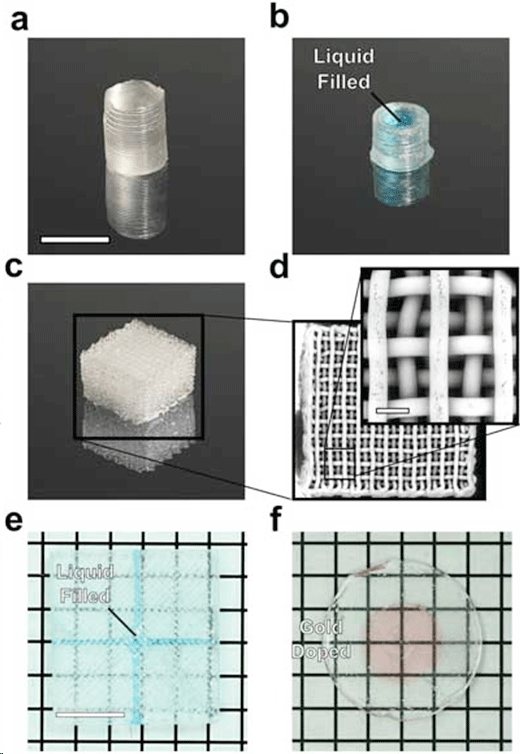|
NOVIDADES
Reporting the findings in Advanced Materials ("3D-Printed Transparent Glass"), the team developed a two-part process (forming and sintering) which uses direct ink writing (DIW) for the 3D printing of optically transparent glass structures with sub-millimeter features.  3D-printed glass structures. a) Solid, monolithic cylinder (20 wt% silica ink). Scale bar 5 mm. b) Cup containing dyed water, highlighting high aspect ratio features (20 wt% silica ink). c) Woodpile scaffold, highlighting gap-spanning features (23 wt% silica ink). d) Scanning electron microscopy of woodpile scaffold. Scale bar 250 µm. e) 3D-printed microfluidic cross junction containing dyed water (23 wt% silica ink). Microfluidic channels are 400 µm wide. Scale bar 4 mm. f) Multicomponent printed glass. Two nozzles containing gold-doped and undoped silica inks are used to print a core–shell structure (20 wt% silica ink). After consolidation into a transparent glass, the gold-doped region retains its red coloration. © Wiley-VCH Verlag
DIW has been used in a wide range of applications such as polymeric optical wave guides, complex scaffolds, 3D periodic graphene aerogels, and self-healing materials. This new process first relies on DIW printing of colloidal silica suspensions to form silica green bodies (porous, low density structures) of the desired shape. A key feature of this process is the ability to control yield stress and shear thinning to obtain ink properties best suited for specific applications of the printed glass. Second, the printed structures are dried and heated to temperatures below the melting point of silica to sinter the green body into a fully dense, amorphous, transparent solid structure. In contrast to direct 3D printing of molten glass, this two-step approach does not require high temperatures during printing and allows for higher resolution features, due to both the ability to extrude thinner filaments and the shrinkage that occurs during the densification stage. The inks are tailored to have optimal drying and rheological properties, and when combined with an appropriate heat treatment process, enable the creation of fully dense glass parts such as monoliths, scaffolds, and 3D-printed microfluidic glass parts. The researchers also demonstrated the fabrication of multi-composition glass parts. "Recent advances in 3D-printing technologies, such as active mixing, could be applied to this general process and result in gradient-composition glass structures with tunable optical and mechanical properties" the authors conclude their report. "For example, routes toward 3D-patterned glass microfluidic reactors and 3D gradient-index optics become accessible with this new forming and sintering approach." Michael Berger – Michael is author of two books by the Royal Society of Chemistry: Nano-Society: Pushing the Boundaries of Technology and Nanotechnology: The Future is Tiny. Posted: Jul 09, 2017. |
|||||||||||||||||||||||||